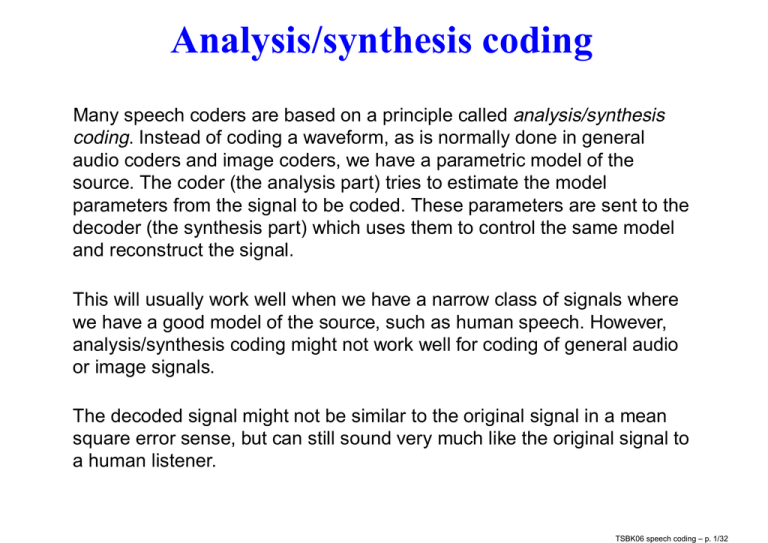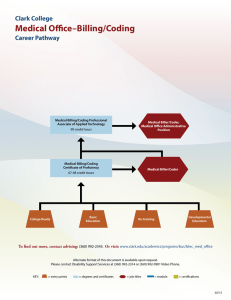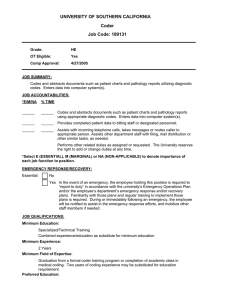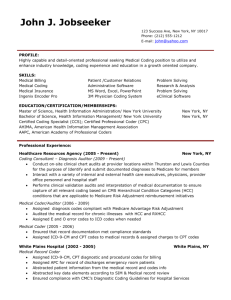Analysis/synthesis coding
advertisement

Analysis/synthesis coding
Many speech coders are based on a principle called analysis/synthesis
coding. Instead of coding a waveform, as is normally done in general
audio coders and image coders, we have a parametric model of the
source. The coder (the analysis part) tries to estimate the model
parameters from the signal to be coded. These parameters are sent to the
decoder (the synthesis part) which uses them to control the same model
and reconstruct the signal.
This will usually work well when we have a narrow class of signals where
we have a good model of the source, such as human speech. However,
analysis/synthesis coding might not work well for coding of general audio
or image signals.
The decoded signal might not be similar to the original signal in a mean
square error sense, but can still sound very much like the original signal to
a human listener.
TSBK06 speech coding – p. 1/32
Analysis by synthesis
A variant of analysis/synthesis coding is analysis by synthesis coding. The
coder also contains a decoder, and tries to find the model parameters that
gives a decoded signal close (in some sense) to the original signal.
TSBK06 speech coding – p. 2/32
Human speech
Sound is generated by forcing air through the vocal cords (located in the
larynx). If the vocal cords are tense, they vibrate and generate tones and
overtones (voiced sounds). If the vocal cords are relaxed, a noiselike
sound is produced (unvoiced sounds).
The sound then passes through the laryngeal cavity, the pharynx and the
oral and an nasal cavities.
Tongue, lips and teeth are also used to influence the sound.
Everything after the vocal cords (the vocal tract) can be well modelled by
a linear filter.
TSBK06 speech coding – p. 3/32
Human speech
TSBK06 speech coding – p. 4/32
Examples of speech sounds
TSBK06 speech coding – p. 5/32
Examples of speech sounds
TSBK06 speech coding – p. 6/32
Model of speech
A simple model of human speech:
Noise
r
r
r
Filter
- Speech
Pulse source
The speech is seen as a sequence of either voiced or unvoiced sounds.
The voiced sounds are modelled as a filtered pulse train, while the
unvoiced sounds are modelled as filtered white noise.
The parameters of the model are filter coefficients, switches between
voiced and unvoiced sounds, and the pulse trains.
TSBK06 speech coding – p. 7/32
Model of speech, cont.
The speech signal yn is modelled as
yn =
M
X
ai yn−i + Gn
i=1
The coder splits the signal into shorts segments of, typically a few
hundred samples (at sampling frequency 8 kHz). For each segment the
coder estimates if the sound is voiced or unvoiced. For unvoiced sounds a
suitable pulse train is estimated. Filter parameters ai and G are estimated.
All these parameters are sent to the receiver, which can then decode the
sound using the model.
The coding us thus a kind of linear predictive coding. One major
difference, compared to our earlier description of predictive coding, is that
the main part of the bit rate is used to send filter coefficients and not the
prediction error.
TSBK06 speech coding – p. 8/32
Pulse trains
The pulse trains can vary in complexity between different coders. Often
the pitch period, corresponding to the fundamental frequency of the
sound, is estimated.
The simplest pulse trains use pulses of the same amplitude at constant
intervals. The pulse train can then be described just by the pitch period
and the start position of the first pulse.
We can also let the amplitudes and positions of the pulses very more
freely. It is then possible to get a pulse train that fits the signal better, but
at the cost of a higher bit rate.
TSBK06 speech coding – p. 9/32
Pulse trains, examples
1
1
0.8
0.8
0.6
0.6
0.4
0.4
0.2
0.2
0
0
−0.2
−0.2
−0.4
−0.4
−0.6
−0.6
−0.8
−0.8
−1
−1
20
40
60
80
100
120
140
160
180
200
20
40
60
80
100
120
140
160
180
200
1
0.8
0.6
0.4
0.2
0
−0.2
−0.4
−0.6
−0.8
−1
20
40
60
80
100
120
140
160
180
200
TSBK06 speech coding – p. 10/32
Voiced or unvoiced?
Voiced sounds usually have a larger energy (larger amplitude) than
unvoiced sounds.
Unvoiced sounds usually contain higher frequencies than voiced sounds.
One way of determining if a segment is voiced or unvoiced can be to
comapare the signal energy with the energy of the background noise, and
to count the number of zero crossings of the sounds.
TSBK06 speech coding – p. 11/32
Estimating the pitch period
The auto correlation function Ryy (k) can be used to estimate the pitch
period P . For a periodic signal, the acf has a maximum at k = P .
Another, better method is to use the average magnitude difference
function (AMDF). It is defined by
1
AM DF (k) =
N
kX
0 +N
|yi − yi−k |
i=k0 +1
where k0 depends on which segment we’re in and N is the size of the
segment. The AMDF will have a minimum where k is equal to the pitch
period of the segment.
The AMDF can also be used to determine if the segment is voiced or
unvoiced. For unvoiced sounds the AMDF will have very shallow minima,
not much different from the average value of the AMDF.
TSBK06 speech coding – p. 12/32
Example
0.6
0.4
0.2
0
−0.2
−0.4
−0.6
0
50
100
150
200
250
A segment of 256 samples from a speech signal.
TSBK06 speech coding – p. 13/32
Example
0.08
0.06
0.04
0.02
0
−0.02
−0.04
0
10
20
30
40
50
60
70
80
90
100
Estimated auto correlation function. Gives pitch period 31.
TSBK06 speech coding – p. 14/32
Example
0.4
0.35
0.3
0.25
0.2
0.15
0.1
0.05
0
0
10
20
30
40
50
60
70
80
90
100
Estimated AMDF. Gives pitch period 31.
TSBK06 speech coding – p. 15/32
Estimating filter coefficients
We want to find ai such that the average value of the quadratic error e2n is
minimized, where
e2n = (yn −
M
X
ai yn−i − Gn )2
i=1
Minimizing the expected value E{e2n } gives the following equation system
∂
E{e2n } = 0
∂aj
⇐⇒
M
X
ai E{yn−i yn−j } = E{yn yn−j }
i=1
In order to solve this we need to estimate E{yn−i yn−j }, which can be
done either by the auto correlation method or by the auto covariance
method.
TSBK06 speech coding – p. 16/32
Auto correlation method
We assume that yn is stationary, which means that
E{yn−i yn−j } = Ryy (|i − j|)
In addition, we assume that the signal is 0 outside of the current segment,
so that we can estimate the auto correlation function as
Ryy (k) =
nX
0 +N
yn yn−k
n=n0 +1+k
TSBK06 speech coding – p. 17/32
Auto correlation method, cont.
The equation system can then be written as
Rā = p̄
where
R=
Ryy (1)
Ryy (0)
Ryy (0)
Ryy (1)
..
..
.
.
Ryy (M − 1) Ryy (M − 2)
. . . Ryy (M − 1)
. . . Ryy (M − 2)
..
..
.
.
...
Ryy (0)
and
ā = [a1 a2 . . . aM ]T
p̄ = [Ryy (1) Ryy (2) . . . Ryy (M )]T
Solve for ā.
TSBK06 speech coding – p. 18/32
Auto covariance method
We do not assume that yn is stationary. We define
cij = E{yn−i yn−j }
which can be estimated as
cij =
nX
0 +N
yn yn−k
n=n0 +1
TSBK06 speech coding – p. 19/32
Auto covariance method, cont.
The equation system can then be written as
Cā = s̄
where
C=
c11
c21
..
.
cM 1
c12
c22
..
.
cM 2
...
...
..
.
c1M
c2M
..
.
. . . cM M
and
s̄ = [c10 c20 . . . cM 0 ]T
Solve for ā.
TSBK06 speech coding – p. 20/32
LPC-10
Old american speech coding standard fo the rate 2.4 kbits/s.
• Segments of 180 sampel
• Pitch period 60 possible values
• 10 filter coefficients for voiced sounds, 4 coefficients for unvoiced
sounds.
• Gives a rather synthetic decoded sound.
• Not so good for high background noise.
TSBK06 speech coding – p. 21/32
Long Term Prediction (LTP)
Often a predictor that utilizes both the most recent samples and samples
one pitch period P back in time is used.
yn =
M
X
i=1
ai yn−i +
K
X
αj yn−P −j+1 + Gn
j=1
The part using αj is called long term prediction and the part using ai is
called short term prediction.
TSBK06 speech coding – p. 22/32
RELP
Regular Excitation Linear Prediction
In a RELP coder no choice between voiced and unvoiced sounds is made.
The pitch period P and filter coefficients ai and αj are estimated. After
inverse filtering we get a residual signal that is lowpass filtered,
downsampled (typically a factor 3 or 4) and quantized and sent sampel by
sampel.
A RELP coder is thus rather similar to a traditional predictive coder, where
the prediction error (the residual signal) is sent. Note that the quantization
is outside the predictor loop. This will work for the short segments that are
used.
TSBK06 speech coding – p. 23/32
Multi-pulse LPC (MP-LPC)
MP-LPC is an analysis by synthesis coder.
The coder estimates filter coefficients. The coder then tries to find an
optimal pulse train (position and amplitude for a number of pulses) that will
be decoded to a signal as close to the original signal as possible.
One disadvantage of MP-LPC is that the coding is rather computation
intensive.
Used in Skyphone, a system for telephony from airplanes, with the rate
9.6 kbit/s
TSBK06 speech coding – p. 24/32
Example, MP-LPC
0.25
0.2
0.15
0.1
0.05
0
−0.05
−0.1
−0.15
−0.2
0
20
40
60
80
100
120
140
160
180
200
A segment of 200 samples from a speech signal.
TSBK06 speech coding – p. 25/32
Example, MP-LPC
We adapt a 5 coefficent filter to the signal using the auto correlation
method. The filter coefficients (before quantization) are:
ā ≈
−1.5373
0.2515
0.2400
0.1754
−0.0912
TSBK06 speech coding – p. 26/32
Example, MP-LPC
A pulse train with ten pulses is optimized so that the decoded signal is as
close to the original signal as possible.
0.08
0.06
0.04
0.02
0
−0.02
−0.04
−0.06
−0.08
0
20
40
60
80
100
120
140
160
180
200
TSBK06 speech coding – p. 27/32
Example, MP-LPC
0.25
0.2
0.15
0.1
0.05
0
−0.05
−0.1
−0.15
−0.2
0
20
40
60
80
100
120
140
160
180
200
Decoded signal.
TSBK06 speech coding – p. 28/32
Example, MP-LPC
0.25
0.2
0.15
0.1
0.05
0
−0.05
−0.1
−0.15
−0.2
0
20
40
60
80
100
120
140
160
180
200
Original signal and decoded signal.
TSBK06 speech coding – p. 29/32
RPE-LTP
Regular Pulse Excitation with Long Term Prediction
The first coding method used in the GSM system. It has later been
replaced by other methods.
Can be seen as a hybrid between RELP and MP-LPC. The coder tries to
find a pulse train that is decoded to a signal as close to the original signal
as possible. The pulses are limitied to be located in a regular pattern.
The coder uses the rate 13 kbit/s. Including error correction we get the
total rate 22.8 kbit/s.
TSBK06 speech coding – p. 30/32
Code Excited Linear Prediction (CELP)
Analysis by synthesis. The coder estimates filter coefficients, and then
tries to find an excitation signal from a codebook that is decoded to a
signal close to the original signal. It is thus a form of vector quantization,
often of the type gain-shape. What is sent to the receiver is filter
parameters, index in the codebook and gain parameters.
Often a combination of a fixed and an adaptive codebook is used.
There are variants where the filter parameters are estimated using the
previous segment. Since the decoder also has access to those old
samples, only index data needs to be transmitted.
TSBK06 speech coding – p. 31/32
CELP in GSM
Enhanced Full Rate Algebraic CELP
Data rate 12.2 kbit/s
Adaptive Multi-Rate Algebraic CELP
Data rate between 4.75 kbit/s and 12.2 kbit/s (in 8 steps). The coder tries
to adapt to the channel quality. If the channel is bad the speech coder will
use a low rate and then many bits are used for error correction. For better
channels not as many bits are needed for error correction and the speech
coder can then use a higher rate.
The channel rate is either 22.8 kbit/s or 11.4 kbit/s (half rate channel).
TSBK06 speech coding – p. 32/32



